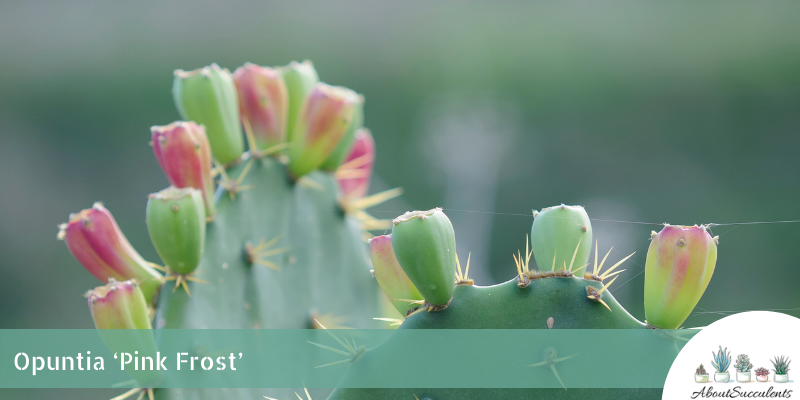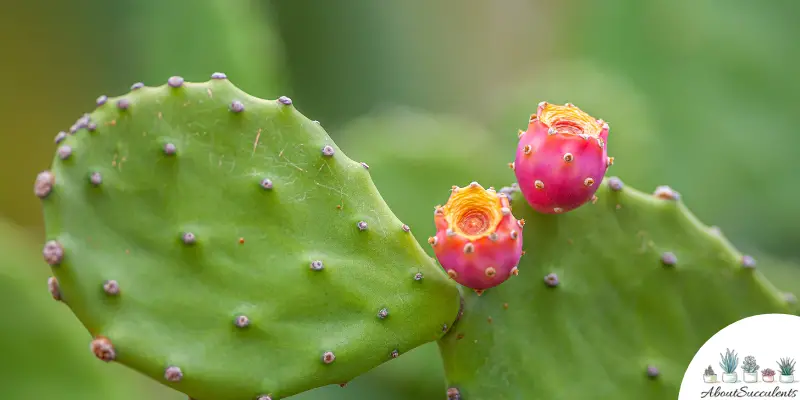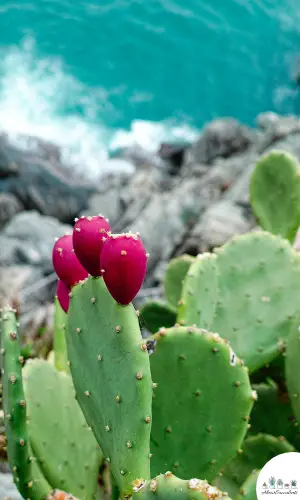
Opuntia “Pink Frost” is a Prickly Pear Cactus that grows into tall, wide, and large shrubs. In spring, this cold-hardy cactus plant gets adorned with adorable rose-like pink blossoms. It will be perfect for a rustic outdoor garden because you can set it up as a living cactus fence.
Opuntia Pink Frost grows up to 12-inches (30.5cm) tall and 6-feet (1.8m) wide. As the plant matures, it spreads out forming a large shrub. This frost-hardy cactus has green fleshy paddle-like stems with tiny and fuzzy spines called glochids.
This Opuntia species is a hybrid of Opuntia Aurea produced by Tom Jesch. This type of succulent is commonly found in the sub-tropical regions in North America and the dry areas in Mexico. It is part of the Opuntia genus of the Cactaceae family.
Opuntia Pink Frost can withstand freezing temperatures and intense heat. It will survive extreme temperatures to as low as -17.7°C (0°F).
General Information
Also known as: Pink Frost
Plant Family: Cactaceae
Origin: Hybrid of Opuntia aurea produced by Tom Jesch; can be found in the sub-tropical regions of North America and in the dry areas of Mexico.
Height: 12-inches (30.5cm)
Exposure: Full Sun
Water Needs: Low; use the “soak and dry” watering method
Soil Type: Cactus soil combined with gravel and coarse sand
Soil pH: 6 to 7.5
How to Grow and Care for Opuntia ‘Pink Frost’

Opuntia Pink Frost is popular with plant lovers because it’s not only a beautiful and durable succulent but it’s also a low-maintenance cactus plant.
Pink Frost will stay healthy for as long as you provide the following growing conditions:
Sunlight
Opuntia Pink Frost grows best in areas exposed to full sun for at least 6 hours a day. When it receives ample sunlight, it will produce sturdy, tall, and wide stacks of stems. It will also bloom every Springtime without fail.
If planted indoors, place the pot near a South-facing window. Turn the pot every week so all sides of the plant will get exposed to sunlight. Make sure to find a sunny area for your pot, otherwise, your plant will suffer from etiolation.
Etiolation is a condition of plants where the stems lose their natural form as it stretches out in search of a better source of light. Lack of sunlight also leads to stunted growth and poor flower production.
Watering

Although Opuntia Pink Frost can store water in their leaves and stems, it still needs to be watered properly to live long and healthy. Overwatering causes root rot while underwatering causes the plant to shrivel.
Use the “Soak and Dry” watering method. Drench the soil until the water comes out of the drainage hole. Wait till the soil dries out completely in between waterings. Do not keep the soil damp for too long to prevent fungal growth.
A hygrometer will help measure the soil’s moisture level but a stick inserted an inch deep will do just fine. If the stick feels dry to the touch, it means Pink Frost needs water.
In the summertime, you might only need to water Pink Frost every seven to 10 days. Again, check the soil’s level of dryness to be sure.
When winter comes, the watering schedule might be every 2 to 4 weeks depending on how soon the soil dries out. Keep in mind that soil tends to retain moisture longer during cold weather.
Pot and Soil
Did Pink Frost come in a plastic container? Discard it right away. It is best to plant your Opuntia Pink Frost in a terracotta or unglazed ceramic pot with a drainage hole because these materials allow excess moisture to evaporate from the soil. These types of pots also support proper soil aeration which is good for the roots.
When it comes to the right size, your pot should be 1” to 2” wider than your cactus plant to give it enough room to grow. It should have a depth of 4” to 7” depending on how long the roots of your cactus are. When you see roots coming out of the drainage hole, it is time to move your cactus to a bigger pot.
For potting soil, use standard cactus mix combined with gritty materials such as perlite, coarse sand, gravel, and pumice.
Fertilize your young ‘Pink Frost’ with a 10-10-10 fertilizer or NPK (Nitrogen-Phosphorus-Potassium) before its growing season begins. Feed your cactus plant once in spring and summer. Lay off the fertilizer when it enters its rest period during the colder seasons.
How to Propagate Opuntia ‘Pink Frost’
Propagating Opuntia ‘Pink Frost’ is not a complicated process. You can multiply your cactus collection by using stem cuttings. The best time to do this is during late spring to early summer when the stems are ready for active growth.
Stem/Pad Cuttings
Step 1: Use a sterile sharp knife or pair of pruning shears to cut off a stem/pad at the joint connecting it to another pad.
Step 2: Leave your pad cutting in a dry and well-ventilated area for 2 to 3 days or until the cut ends calluses or seals.
Step 3: Get a terracotta pot with a drainage hole. Fill it with cactus soil combined with perlite and gravel. Gently insert the pad cutting (calloused end first) into the soil.
Step 4: Place the pot in a warm area, away from direct sunlight. Mist the soil three times a day. After three weeks, your Opuntia ‘Pink Frost’ should start rooting.
Frequently Asked Questions
Is Opuntia “Pink Frost” Toxic to Cats and Dogs?
No. Opuntia Pink Frost is not included in the list of plants that are toxic to cats and dogs on the website of the American Society for the Prevention of Cruelty to Animals (ASPCA).
If potted indoors, it is best to place it in an area away from pets and children because glochids can cause skin irritation.
Why is my Opuntia “Pink Frost” Dying?
It is frustrating when your plant gets sick, especially when you have been caring for them for a long time. The key to preventing your plant’s demise is to treat it immediately after you detect symptoms of the following:
Overwatering
Cactus plants are very averse to waterlogged soil. The roots get heavily damaged when it sits in damp soil frequently. When you see the stems and base of the plant turn brown or black and become mushy, you need to repot it immediately to save it from dying.
Gently remove your Opuntia Pink Frost from the pot. Remove all the soil from the roots and cut away all the damaged ones with a sterile sharp knife or pair of pruners.
Leave the plant in a dry area for 2 to 3 days. Replant it in a pot filled with fresh cactus soil combined with perlite, coarse sand, and pumice. Wait three days before you water the soil.
If all the roots have been damaged, check if there are healthy stems/pads left. Cut the healthy stems with a sterile sharp knife. Leave the stem cuttings in a dry area until the cut ends close up. Plant the cuttings in separate pots filled with cactus soil mixed with gritty materials.
Pest Infestation
Opuntia Pink Frost is susceptible to cochineal scale bug infestation. This sap-sucking pest multiplies rapidly and can kill your plant if not removed on time.
If the infestation is mild, you can remove the scale bugs by spraying your plant with water using a pressure hose. If your plant is already heavily infested with cochineal scale, use neem oil to get rid of the bugs.
Mix 1 part cold-pressed neem oil with 2 parts water. Spray it on your cactus plant twice a week for three weeks or until you get rid of all the pests. Pour some of the solution into the soil to kill the eggs in there.
You can also spray your plant with a soap and water solution. Mix 1 tablespoon of liquid dishwashing soap with 2 cups of water. Another alternative remedy is to spray your plant with 99% rubbing alcohol twice a week until all the bugs are gone.
Make sure to quarantine your infested plant during treatment. Place it in an area away from direct sunlight because neem oil and alcohol can cause sunburn. For heavily-infested cactus, it would be best to repot it in fresh cactus soil after treatment.
Yes. Plenty of rose-like pink flowers settling on the outer edges of the pads bloom in June and July.
Last Updated on June 9, 2022 by Sofia Lara